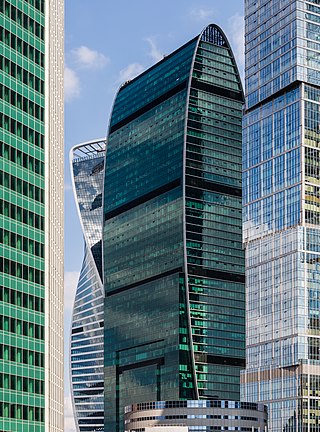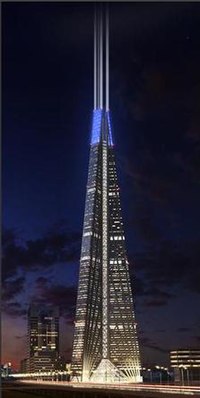
Fountain Place is a 60-story late-modernist skyscraper in downtown Dallas, Texas. Standing at a structural height of 720 ft (220 m), it is the fifth-tallest building in Dallas, and the 15th-tallest in Texas. A new 45-story sibling tower, AMLI Fountain Place, has been built to its northwest on an adjacent lot.

One Snow Hill Plaza is a highrise hotel in Birmingham, England. It is 72 metres (236 ft) tall and was completed in 1973. In 2013 the building was renovated and became a 224-room hotel under the brand Holiday Inn Express.
The City Hall and City Duma would have been the new home for the Moscow government and assembly (duma). It would have consisted of four 308.4 meter (1011.8 feet), 70 story towers. Currently, the government of the city are using hundreds of smaller buildings throughout the city. It was expected that most of the city's central administration will be gathered in the new complex to provide better organization, allowing the buildings currently in use to be sold.
The Burj Al Alam was a proposed 108-story, 510 m (1,670 ft) hyperboloid skyscraper in the Business Bay area of Dubai, United Arab Emirates, though the project's roots are in a 101-storey design called "Fortune 101" and slated for the Dubai Marina area. It was designed to resemble a crystal flower. If constructed, it would have become one of the world's tallest buildings. The tower was one of the projects of the Fortune Group, which has a number of other projects in Dubai such as the Fortune Bay and Fortune Tower.

Mercury City Tower is a supertall skyscraper located on plot 14 in the Moscow International Business Center (MIBC), in Moscow, Russia. Occupying a total area of 173,960 square metres (1,872,500 sq ft), the mixed-use building houses offices, apartments, a fitness center, and retail stores.

The Bow is a 158,000-square-metre (1,700,000 sq ft) skyscraper in downtown Calgary, Alberta, Canada. The 236 metre (774 ft) building was the tallest in Calgary between July 8, 2010, when it surpassed the Suncor Energy Centre, and May 11, 2016, when it was exceeded by Brookfield Place. The Bow is currently the second tallest office tower in Calgary and the third tallest in Canada outside Toronto. The Bow is also considered the start of redevelopment in Calgary's Downtown East Village. It was completed in 2012 and was ranked among the top 10 architectural projects in the world of that year according to Azure magazine. It was built for oil and gas company Encana, and was the headquarters of its successors Ovintiv and Cenovus.

The Lakhta Centre is an 87-story skyscraper built in the northwestern neighbourhood of Lakhta in Saint Petersburg, Russia. Standing 462 metres (1,516 ft) tall, it is the tallest building in both Russia and Europe, and the sixteenth-tallest building in the world. It is also the second-tallest structure in Russia and Europe, behind the Ostankino Tower in Moscow, in addition to being the second-tallest twisted building and the northernmost skyscraper in the world.

Imperia Tower, is a complex located on plot 4 of the MIBC in Moscow, Russia. The 287,723 square metres (3,097,020 sq ft) mixed-use complex includes a completed 60-story skyscraper with a height of 239 metres (784 ft) and a 14-story building with a height of 53 metres (174 ft) that is currently under construction. Construction of the skyscraper started from 2001 to 2002, but halted in 2003 until it was resumed in 2006 and was completed in 2011. The 14-story building started construction in 2013 and finished by 2018. The 60-story skyscraper of the complex is the fifteenth-tallest building in Russia, and the 24th-tallest building in Europe.

Naberezhnaya Tower is an office complex composed of two skyscrapers and a high-rise located on plot 10 in the Moscow International Business Center (MIBC) in Moscow, Russia with a total area of 254,000 m2 (2,730,000 sq ft). The buildings are named after the first three letters of the alphabet and from the lowest height to the tallest: the 17-story tall Tower A, the 27-story tall Tower B, and the 59-story tall Tower C. Construction of the complex started in 2003, with Tower A being completed in 2004, Tower B in 2005, and Tower C in 2007.
The American Commerce Center was a proposed supertall skyscraper approved for construction in Philadelphia, Pennsylvania but cancelled due to the 2008 recession. The Comcast Technology Center, the tallest skyscraper in both Philadelphia and Pennsylvania, now stands on the site.
Sibir Energy was AIM-listed British oil company, whose primary line of business is petroleum and natural gas exploration in Siberia, Russia. Since February 2011, it is a wholly owned subsidiary of Gazprom Neft. In February 2016, Gazprom completely liquidated Sibir Energy as a separate company.
The Encinal Tower was a skyscraper proposed for construction in Downtown Oakland, California. The mixed-use tower was planned to rise 715 feet (218 m) and contain 56 floors for office and residential use. The project design consisted of a glass and X-bracing-covered cylindrical building with one side that resembles a roll of fabric unraveling. If built, the skyscraper would have been the tallest building in Oakland and third-tallest in the Bay Area after 555 California Street and the Transamerica Pyramid, both located in San Francisco. The project had undergone several design and name changes since it was first proposed in 2006. The proposal was withdrawn in 2010, and in 2012 the property sold to a developer who plans a much smaller tower.

The City of Capitals is a mixed-use complex composed of two skyscrapers and an office building located on plot 9 in the Moscow International Business Center in Moscow, Russia with a total area of 288,680 square metres (3,107,300 sq ft). The two skyscrapers are named after the two historical capitals of Russia: Moscow and Saint Petersburg. Construction of the complex began in 2005, with the office building completed in 2008 and the two skyscrapers completed in 2009.
1 Dubai was a complex of three skyscrapers proposed for Jumeirah Garden City in Dubai, United Arab Emirates. Tower 1 would have been the tallest and Towers 2 and 3 much shorter. Although the planned height was never officially released, various heights over 1,008 m (3,307 ft) were suggested, with the intention to be taller than Burj Khalifa which was under construction at the time. The complex was designed by Adrian Smith + Gordon Gill Architecture, and the developer was Meraas.

Shalva Chigirinsky is an Israeli-Russian businessman, who was the major shareholder of AIM-listed British oil company Sibir Energy Plc. As a principal owner of Russian Land Ltd, he was involved in the implementation of major development projects: the reconstruction of Hotel Rossiya, the construction of the Russia Tower in Moscow, the construction of the cultural and business center Crystal Island, and the reconstruction of New Holland Island in Saint Petersburg. In 2008, Forbes ranked him as the 524th richest person in the world and 58th on its list of Russian billionaires.

The Evolution Tower is a skyscraper located on plots 2 and 3 of the MIBC in Moscow, Russia. The 55-story office building has a height of 246 metres (807 ft) and a total area of 169,000 square metres (1,820,000 sq ft). Noted in Moscow for its futuristic DNA-like shape, the building was designed by British architect Tony Kettle in collaboration with University of Edinburgh's Professor of Art Karen Forbes. Construction of the tower began in 2011 and was completed in late 2014. In 2016, Transneft bought the Evolution Tower for US$1 billion to establish its headquarters. The skyscraper is the twelfth-tallest building in Russia, and the 20th-tallest building in Europe.
Okhta Center or phonetically Oḱhta-Tseńtr, known before March 2007 as Gazprom City (Russian:Газпро́м-си́ти), was a construction project of a business centre in Saint Petersburg, Russia. It was supposed to include the first supertall skyscraper in the city. The 403 meters high main tower of Okhta Centre is set to be the tallest building in Europe amongst live building proposals. This project, remained unrealised, was supposed to house headquarters of the Gazprom energy company, along with museums, library, sports and leisure facilities, and a concert hall. It was to be built in the mouth of the river Okhta, on the right bank of the river Neva. Its 403-meter high tower was conceived not only as a dominant, but also as a new symbol of Saint Petersburg. It was to be completed by 2016. However, the project met fierce opposition from citizens, civil groups, and international organizations. When the project ideas were introduced to international jury, three out of four architects walked off the jury in protest, the competition was also boycotted by the Russian Union of Architects. It was eventually relocated to the new site Lakhta in Saint Petersburg in December 2010.

OKO is a complex of two skyscrapers located on plot 16 in the Moscow International Business Center (MIBC) in Moscow, Russia. Occupying a total area of about 250,000 square metres (2,700,000 sq ft), the mixed-use complex houses apartments, office space, a 5-star hotel, and other commodities.

The IQ-quarter is a mixed-use complex composed of two skyscrapers and a high-rise located on plot 11 in the Moscow International Business Center (MIBC) in Moscow, Russia with a total area of 201,430 m2 (2,168,174 sq ft). The skyscrapers are named Towers 1 and 2, with the latter being the tallest, and the high-rise just known as the IQ-quarter hotel or Tower 3. Construction of the complex began in 2008 and finished in 2016.














